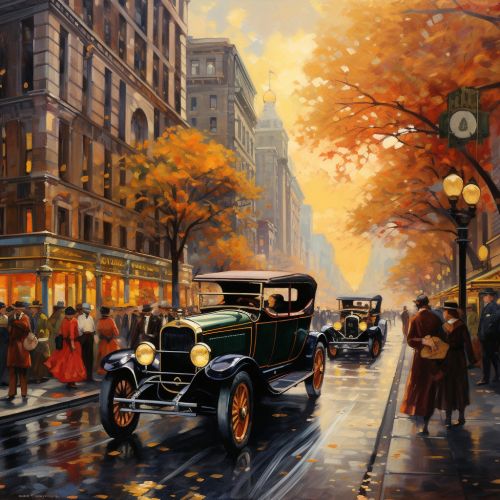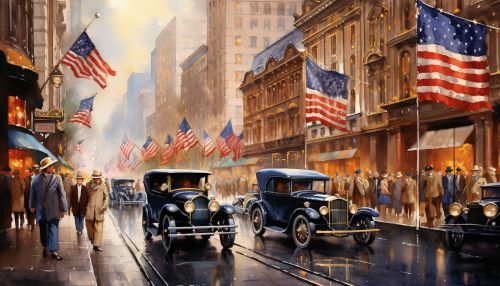Roaring Twenties
Overview
The Roaring Twenties was a decade of economic growth and widespread prosperity, driven by recovery from wartime devastation and deferred spending, a boom in construction, and the rapid growth of consumer goods such as automobiles and electricity in North America and Europe. The economy of the United States, which had successfully transitioned from a wartime economy to a peacetime economy, boomed and provided loans for a European boom as well. Some sectors stagnated, especially farming and mining. The United States became the richest country in the world, and the world leader in industry and agriculture.


Economic Prosperity
The Roaring Twenties was marked by a period of strong economic growth in the United States after World War I. The nation enjoyed a period of sustained prosperity, marked by a boom in technology and the birth of a consumer society. The economy grew 42% during the 1920s and the Gross National Product (GNP) was also very strong. This economic growth was particularly noticeable in the automobile industry where mass production and the assembly line allowed for more efficient production, leading to lower costs and higher wages.
Social and Cultural Change
The Roaring Twenties also brought about significant social and cultural change. The decade saw the large-scale use of automobiles, telephones, motion pictures, and electricity, which led to a new way of living. The proliferation of electricity-powered appliances and the advent of the radio changed the way people lived their daily lives. This period also saw significant changes in lifestyle and culture, particularly in major cities. The introduction of the radio, cinema and advertising led to a new era of mass culture. In many ways, it marked the beginning of modern America.
Prohibition
One of the most notable aspects of the Roaring Twenties in the United States was Prohibition, the federal law that made it illegal to manufacture, sell, or transport alcoholic beverages. This led to the rise of organized crime and illegal speakeasies. Despite the intention of Prohibition to eliminate the use of alcohol, it ultimately led to the opposite effect, with a notable increase in alcohol consumption in many sectors of society.
The Jazz Age
The Roaring Twenties is often synonymous with the Jazz Age, the term coined by F. Scott Fitzgerald to describe the flamboyant "anything goes" era that emerged in America after World War I. The Jazz Age was a cultural period and movement that took place in America during the 1920s from which both new styles of music and dance emerged. Largely credited to African Americans employing new musical techniques along with traditional African traditions, jazz music expanded on the existing musical repertoire in exciting new ways.
The Great Depression
The Roaring Twenties ended with the devastating Great Depression, which led to widespread unemployment and poverty. The stock market crash of 1929, and the ensuing Great Depression, brought an end to the prosperity of the Roaring Twenties. The end of the decade was marked by the Wall Street Crash of 1929, which led to the Great Depression. The economic prosperity of the 1920s came to a sudden end in October 1929 when the stock market crashed, wiping out millions of investors.
